Oman is the quintessence of Arabia imagined -- with its haunting scents, its old-world marketplaces and its untamed desert jostling for space with all the trappings of modernity
It was hard to argue with his conviction but then, a few days in Oman’s capital Muscat left me completely smitten. I returned with the impression that Oman may have indeed been the original Arabia of Sindbadian times -- its long, spectacular coastline of cerulean waters and ancient markets redolent of spices and echoing with Urdu, Malayalam and Gujarati might testify to that. And if you drive by the postcard-inspiring Muttrah Corniche at dusk, just a glance at the gigantic dhows moored in the marina will transport you to the realms of the Arabian Nights.
Another reason tempts me to strengthen my case. Muscat may not have Dubai’s nightlife or Qatar’s pomp, but it has something else that runs deep -- culture. Its shared history with the Indian subcontinent dates back many centuries. Recently, a potsherd with Brahmi script estimated to date back 1,900 years was discovered in Oman. If you care for present-day international relations, the Sultanate governed by the charismatic and respected Sultan Qaboos bin Said is one of India’s most trusted allies in the Arab Gulf.
To the traveller, Oman offers everything from sightseeing and shopping to cuisine, adventure and nature. Here are seven precious experiences, which I recommend that you take home from Oman.
1) Sultan Qaboos Grand Mosque Most Omani Muslims are neither Sunni nor Shia; they owe allegiance to the Ibadi sect, which is one of the oldest schools of Islam founded 50 years after the prophet Muhammad’s passing. Named after its chief patron, Oman’s ruler Sultan Qaboos, the Grand Mosque was built in 2001 and its construction utilised 300,000 tonnes of Indian sandstone.
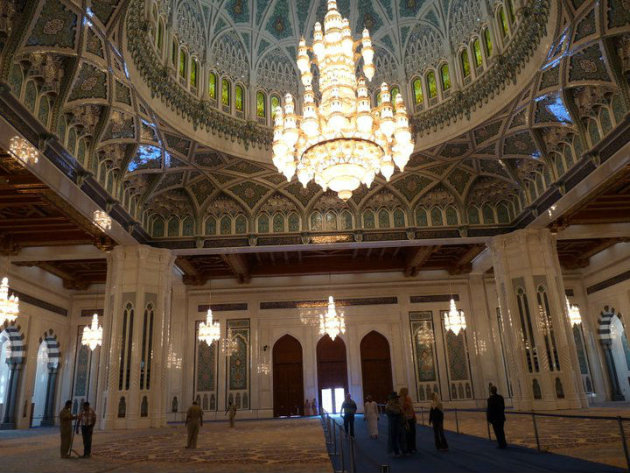
A magnificent 14-metre-high Swarovski crystal chandelier at the Grand Mosque
The mosque grounds are a veritable oasis in the 45-degree desert heat. They are planted with rows of lush neem trees in which sunbirds, bulbuls and doves seek refuge. The lawns are a welcome green and the drip-irrigated flowerbeds are in riotous flower. The mosque complex and the grounds sprawl over 416,000 square metres. The gold-plated dome rises 50 metres, along with an imposing 90-metre main minaret. The women's prayer hall has ceilings of Indian teakwood and walls engraved with Quranic verses in ornate thuluth calligraphy. The spacious main musalla (prayer hall) can accommodate 6,500 worshippers. Its highlight is a magnificent 14-metre-high Swarovski crystal chandelier. It shines down on the world's second-largest handwoven Iranian carpet. Non-Muslims are not permitted to walk directly on the carpet; they are restricted to a blue cloth-covered walking perimeter from where they can view the features of the mosque. The walls are lined with shelves of Holy Quran, and their hue and design are in faithful harmony with the patterns on the carpets, windows, ceilings and doors.
2) A night on the dunes
Though air-conditioning is ubiquitous in Oman, to know the true colour of scorching heat you must visit the dunes. This is the authentic desert -- hundreds of square kilometres of shifting sand dunes rippled by the wind’s erratic calligraphy, cud-champing dromedary camels, and the desert’s intriguing inhabitants -- the once-nomadic Bedouin.
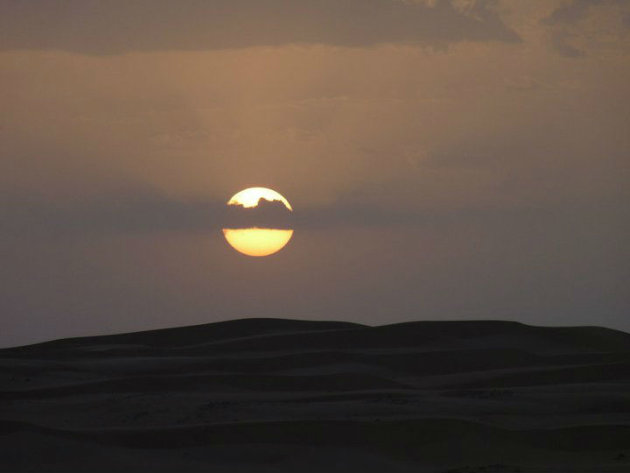
Sunset over the desert in Wahiba Sands, Oman
Wahiba Sands (also known as Sharqiya Sands) is the province of the Wahiba tribe of Bedouins and measures 14,500 square kilometres in total area. The dunes rise nearly 200 metres and tower around us like waves frozen in a dun-coloured ocean. Dune-bashing is a favourite pastime of the guides and offers them the perfect opportunity to exhibit some reckless but skilled driving on the dunes. Before entering the dunes, they lowered the air pressure on the Land Cruiser’s tyres for greater traction on the soft, slippery sand. Then, adrenalized, they raced at terrifying speed, whipping up mammoth clouds of dust.
We stopped at a Bedouin tent and were offered coffee by a striking Bedouin woman, her eyes lined darkly with kohl. Her hands and feets were deep orange with henna. She said it kept her body cool in the roasting desert heat. Inside the tent, away from the glare of the sun, it was still a suffocating 40 degrees.
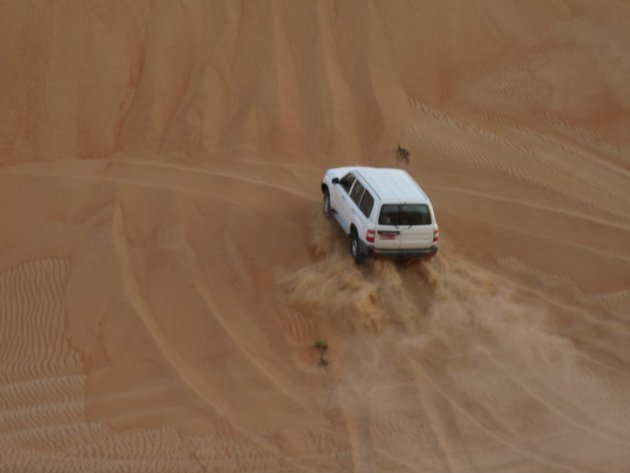
Dune-bashing with SUVs is a favourite pastime in Oman
Just before we checked in at the luxurious Desert Nights Camp, we watched the sunset from the dunes - the blood-red sun sank slowly on the hazy horizon. The desert night is a phenomenon. All through the early evening, the wind whipped up a light, fine dust that penetrated everything. The temperature dropped to a very pleasant 20 degrees and the moon painted the ribbed dunes in silver. An oud player strummed his instrument, punctuating the quiet night with melancholic strains.
3) Wadi Bani Khalid and Bimmah Sinkhole
It’s easy -- and naïve -- to imagine a desert as a vast waterless expanse. The various kinds of desert that I encountered in Oman ranged from bare to scrubby and rocky and some were studded with thorn trees. Another popular illusion is one of the oasis -- from reading tales handed down by travellers, one expects it to be a waterhole fringed by palm trees.
Boys swim at noon in the jewel-like watercourse of Wadi Bani Khalid.
Wadi Bani Khalid upturned both of those impressions. Wadi is a term used across Arabia and the Middle East for watercourses in the desert. Wadi Bani Khalid is the mouth of an underground aquifer. The arid off-white landscape, blazing under the sun, turns suddenly lush and verdant as you approach the wadi from the road. Thick clusters of date palms interspersed with fields of fodder grasses, shrubs, herbs and fruiting trees such as citrus, papaya, guava and mangoes dangling on stringy green stalks were everywhere. The bushes swarmed with birds. The wadi’s aquamarine blue waters were translucent and clear. Fish swam in it, dragonflies pirouetted in the air, and water spiders wove nests of bubbles on the surface. Boys were diving happily into the cool water from a bridge and, though we burned equally from heat and envy, we had no choice but to stand helplessly in our touristy attire and watch.

The Bimmah Sinkhole is stunning both for its extraordinary size and beauty.
Bimmah Sinkhole, close to the coast on the road from the city of Sur to Muscat, was the next unearthly spot. A sinkhole is formed when the earth’s surface layer collapses to reveal an underground cave or depression, often filled with water. In this case, the ground over a subterranean aquifer had collapsed, revealing a striking jade-green and sapphire-blue pool of water 40 metres wide and 20 metres deep. A walkway leads you right down to the water’s edge. Seawater mixes with freshwater through an underground channel, resulting in an algal bloom that causes this fantastic gradient of colours.
4) Jabreen Castle
The heart of modern-day Oman was once a separate nation -- the Imamate of Oman, differentiated from the Sultanate of Muscat. From Muscat, the 175-km drive to the ancient city of Nizwa, the governing seat of the erstwhile Imamate, takes a little over two hours on smooth macadam roads. With certain detours, the ride passes by two very special sights -- the ancient Bahla Fort (one of Oman’s oldest forts, dating back to the 12th century, and a UNESCO World Heritage Site), and the underground limestone caves at Al Hoota.
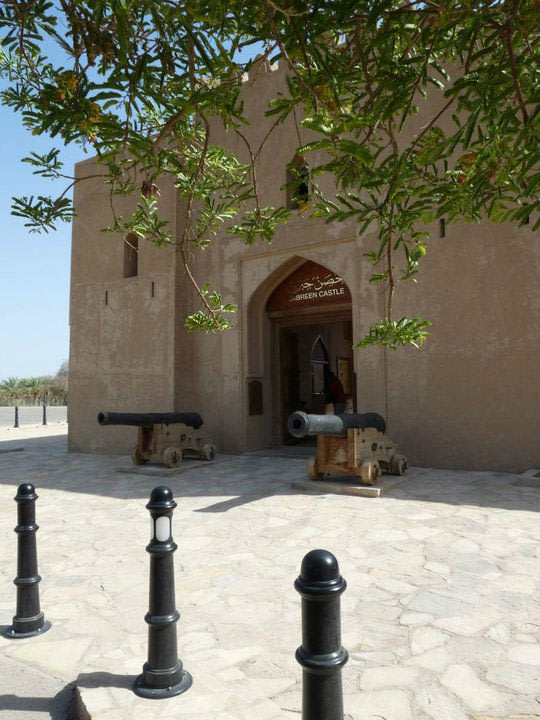
The entrance to the picturesque Jabreen Castle in interior Oman
A gnarled tamarind tree, lush of leaf, welcomes you to the beautiful Jabreen Castle, just 20 km from Bahla. Built by Imam Bil'arab in 1670, its labyrinthine interiors are built over two sections containing two and three floors respectively that echo the twittering of thirsty sparrows. Groves of date palms surround the castle while paintings and ornate Islamic calligraphy adorn the walls inside. Despite the dehydrating heat of the desert outside, the interiors remain cool.
The Imam’s tomb, located left of the entrance, is believed to be haunted by a curse, or so say the guides, teasing mirthfully. Superstitious tourists are tricked into kissing the wall of the tomb seventeen times for fear of ill luck!
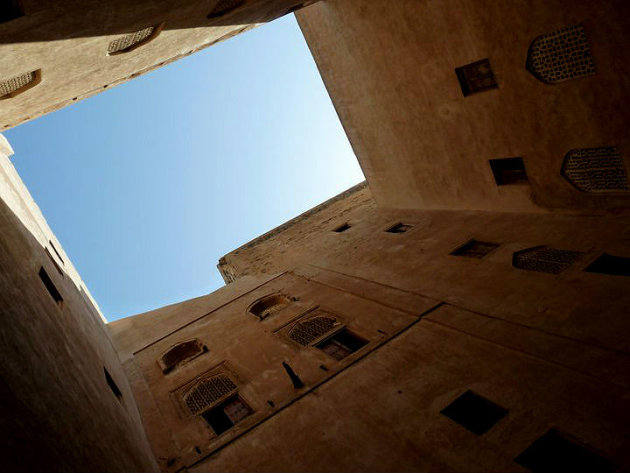
The stately interiors of the Jabreen Castle in Oman
Defying the curse, I did not kiss the wall. Lost in the twisted bowels of the castle, I called out for help, much to our guide’s amusement.
5) A taste of Shuwa
To the Indian palate Omani cuisine is familiar yet unique in taste and flavour. Owing to centuries of spice trade between the Indian subcontinent and Arabia, the cuisine is inflected with notes of cardamom, pepper and saffron.
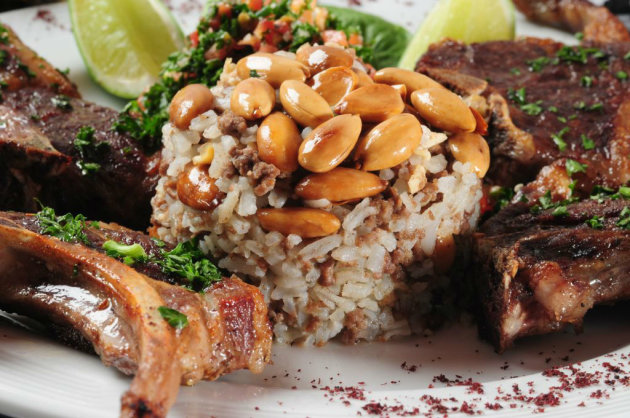
Arabic cuisine is rich in spicy flavours. Photo: ThinkStock
With their scents of char-grilled kababs and shawarma, the open-air cafeterias in the Muttrah Corniche are inviting but our guide, warning us not to ruin our appetites, hustled us off to Kargeen Caffe. Hookahs bubbled in the dimly lit garden restaurant and the smell of food was tantalising.
We nibbled on hummus and pita bread as we awaited our orders. When mine arrived, I could barely take my eyes off it. I had ordered Shuwa, an elaborately prepared dish that was originally a festive meal of desert Bedouins. To make Shuwa, an entire cow or goat (or even a camel, I was told) is marinated with condiments and spices such as red pepper, cumin, turmeric, cardamom, garlic and vinegar and wrapped in banana leaves. It is then slow-cooked -- often for up to 48 hours -- in an underground clay oven, a process that allows the juices to blend perfectly and cooks the meat to buttery tenderness. The choice cuts are served wrapped in banana leaves on a bed of hot saffron rice. So aromatic, succulent and delicious was it that it brought tears of joy to my eyes.
6) Cool off in the Jebel Shams mountains
A hill station in the desert? Unfathomable! To imagine it, you must first cast aside the cliches of what a hill station ought to look like. No tea gardens or pine groves. No waterfalls and high-altitude lakes. Just sober grey mountains of what looks like compressed sand, rising in forbidding spires from the desert floor. The valleys between them were ringed by dessicated ghost rivers lined with pebbles and scree that come alive in a spate of destructive flooding when it rains.
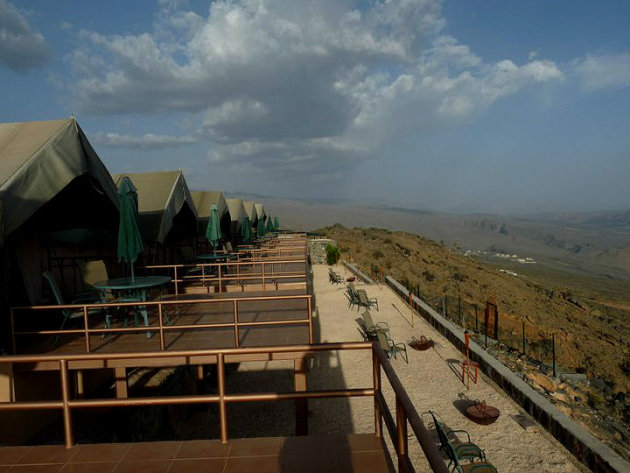
The View camp at Hail Al Shas in the Jebel Shams mountains of Oman
From Nizwa, in the interior of Oman, we drove past Al Hamra, an ancient village of mud dwellings remarkably preserved and inhabited by people who had equipped them with the modern comforts of air-conditioners and refrigerators. The road climbed upward into the Al Hajar mountains, getting more desolate and lonely. At one point, we gazed into a cavernous, seemingly bottomless valley in which Egyptian vultures were flying far below -- this was Oman’s own Grand Canyon.
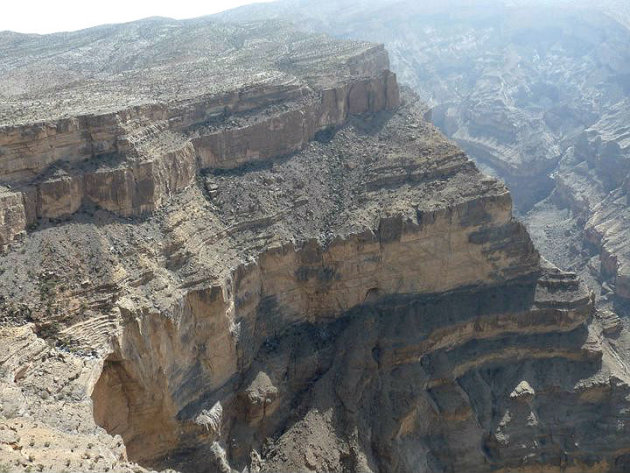
Oman's own
Off-roading, our guide drove us up along a craggy mountain road to The View camp at Hail Al Shas. Here the temperature was a comfortable 30 degrees Celsius and we looked with longing at the tents that were to be our accommodation for the night. As the sun dipped and the moon came out, the valley of Al Hamra glowed like a huddle of fireflies.
Lit by a giant yellow moon, the desert night here was cool and pleasant, and different from the one I enjoyed in the dunes. All night, I left the tent flap open in a joyous invitation to the breeze.
7) Amouage Perfume Factory
“All the perfumes of Arabia will not sweeten this little hand,” cried Lady Macbeth in hysteria. Hands of all sizes, however, will return smelling divinely kissable after a visit to the Amouage perfumery.
Arabia is married to perfumes. And Oman’s regal seal is stamped on the range of exquisite fragrances manufactured by Amouage.
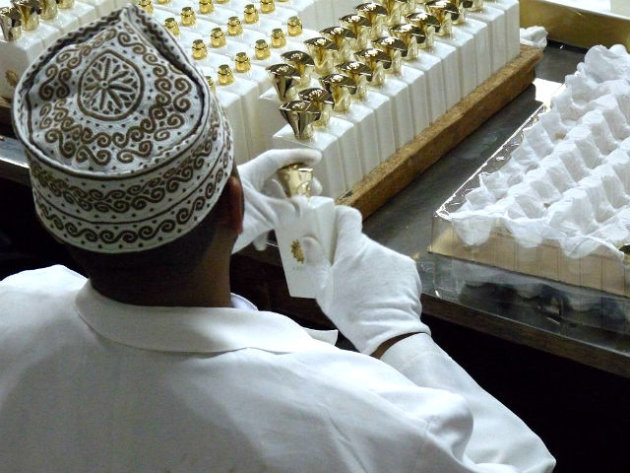
A worker packs bottles at the Amouage Perfume Factory in Rusayl, Oman
Amouage Perfume Factory in Rusayl, Muscat opened in 1983 when the sultan commissioned Guy Robert, the French master perfumer behind Chanel, Dior and Hermes, to create "the most valuable perfume in the world". With top notes of Lily of the Valley, rock rose and silver frankincense, heart notes of iris, patchouli and cedarwood, and bottom notes of civet, sandalwood and ambergris, it is described as the “ultimate symphony.”
Buy it you must, but if you can’t afford to do so, despair not. Guests are taken on a tour of the factory, led by a gracious and well-spoken hostess, to learn how the exquisite perfumes are manufactured, sorted and bottled. As with many other industries in Oman, women comprise a fair share of the workforce, sharing workspaces with traditionally dressed men

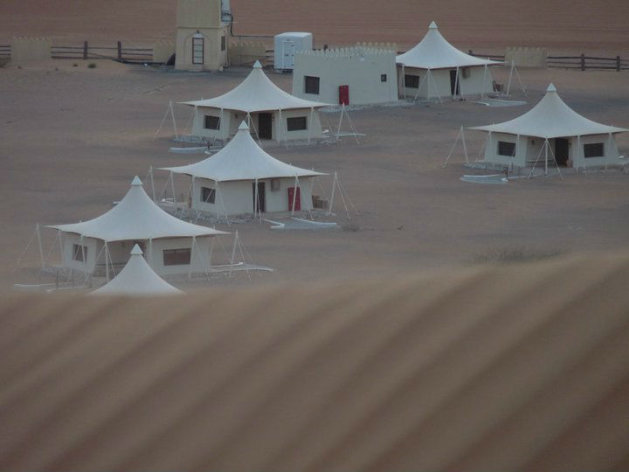
No comments:
Post a Comment